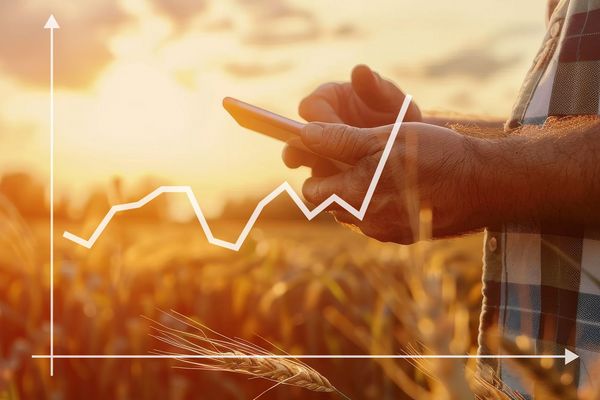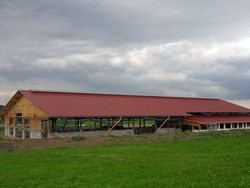Dossier
Farm income
Eva-Charlotte Weber, Daniela Gidalova, Heiko Hansen | 05.09.2025
Farm incomes are subject to strong fluctuations: The prices a farm can achieve for a liter of milk or a kilo of meat change from year to year - as do the prices for seed, fertiliser, feed and energy. We analyse income development over time.

Based on the German Farm Accountancy Data Network (German FADN), we can assess the economic situation and development of agricultural holdings in Germany. This database comprises the accounting data of representatively selected farms. We also use the German FADN for policy impact assessments - for example, how a new design of CAP direct payments will affect farms.
Data basis
The beginnings of the German FADN date back to the 1955 Agriculture Act. The German FADN is of great importance for policy impact assessment and evaluation, because it is the only representative data basis that includes not only farm structure and production characteristics of agricultural holdings, but also but also yields, expenses and revenues. Currently, about 7,500 farms provide their accounting data.
German FADN data are also a central component of the farm programming model FARMIS, which we use to model agricultural activities in detail at farm level and make projections. Using individual weighting factors, we can also extrapolate our results to the represented population under consideration.
Income development over the past 15 years
On average across all farms, agricultural income per unpaid (family) worker has increased over the past 15 years. However, there have been considerable fluctuations: between around €27,000 in the 2009/10 marketing year and most recently around €80,000 in the penultimate 2022/23 marketing year.
Over the past 15 years, nominal incomes have risen by an average of 4.8 per cent per year with significant annual fluctuations, while real incomes have risen by three per cent per year. This difference arises because the inflation rate and therefore the actual purchasing power is not taken into account in the nominal income trend, whereas it is in the real income trend.
In both nominal and real terms, the income per unpaid (family) worker reached record levels in each of the last three financial years 2021/22, 2022/23, and 2023/24. In the most recent economic year, the second-highest (in nominal terms) and third-highest (in real terms) income of the past 15 years can be observed.
This average analysis of all farms does not take into account the major differences in agriculture, e.g. due to specific production methods, farm sizes and regional location factors.
The average incomes between the different types of farms vary considerably in some cases over the 15 financial years considered. For example, arable farms had a higher average income per unpaid (family) worker than the other types of farms. Other forage farms had by far the lowest income. In the most recent financial year 2023/24, processing farms achieved the highest income per unpaid (family) worker.
One reason for the exceptionally good 2019/20 financial year for processing companies was the strong demand for pork from China as a result of the outbreak of African swine fever (ASF) there. In the following financial year, demand for pork from Germany slumped again as the first cases of ASF were detected in this country too. The income of processing companies therefore fell again, but has since recovered gradually and reached its highest level in the 2023/24 financial year. The decisive factor here was the renewed increase in revenues.
All types of farm show a wide variation in income. The dispersion is particularly pronounced among horticultural farms, but is also comparatively high among arable and finishing farms. On average over the three marketing years 2021/22 to 2023/24, the farms generated an average income of almost €66,000 per unpaid (family) worker.
The quantiles shown illustrate how income is distributed. Half of all farms generated an income of less than €46,000 (median) and a quarter of the farms generated around €20,000 or less (25% quantile). In contrast, the most successful quarter of farms (75% quantile) generated an income of more than 88,000 euros. Less than 10 percent of farms suffered income losses, while the income of the most successful 10 percent of all farms amounted to more than €154,000 per unpaid (family) worker (90% quantile).
It also shows that the arithmetic mean in all types of businesses shown is above the median, which indicates that some businesses generate very high incomes and thus push up the average (arithmetic) income. This is particularly pronounced in horticultural farms, which had comparatively high average incomes per unpaid (family) worker in recent financial years (see chart “Income development per unpaid (family) worker by type of farm”).
Direct payments are a central point of discussion when it comes to the future direction of the Common Agricultural Policy (CAP). Analyses of the accounting statements from the Test Farming Network show that direct payments are a key component of farm income.
On average over the last three marketing years (2020/21 to 2022/23), they accounted for around 30 per cent across all farms - i.e. almost a third of income. The share of direct payments in income per (family) worker is highest on forage and arable farms. In farms with high added value per hectare - viticulture, fruit growing and other permanent crops, horticulture - their share is the lowest.
In general, it should be noted that the share of direct payments in profit fluctuates from year to year. This is mainly due to the annual ups and downs in profit, while direct payments that are decoupled from production and are area-related remain relatively constant over time.
Another frequently used form of presentation is the share of direct payments in farm income. According to this, they account for an average of almost six per cent across all farms. On farms with a high value added per hectare - such as horticulture, viticulture, fruit growing and other permanent crop farms - the share of direct payments in farm income is significantly lower than on arable and other forage farms.
Against the background of these figures, it is often argued that direct payments are of existential importance for farms due to their high share of profits and their income-stabilising effect. However, in the case of leased land, a large proportion of the area-related direct payments are passed on to the landowners. Empirical studies show that these so-called pass-on effects are likely to account for around 50 to 60 per cent of direct payments. The higher the proportion of leased land and the longer the lease agreements are still in force, the greater the effects. For this reason, a reduction or reorganisation of direct payments should be planned over several years and be progressive and reliable so that a gradual ‘recirculation’ can take place.
We refer to the income of family-run agricultural businesses in Germany with the legal forms of sole proprietorships or partnerships. They account for around 98 percent of agricultural businesses (Federal Statistical Office 2024). We also focus on full-time farms and do not include small and part-time farms in our analysis.
The income of unpaid (family) workers is determined from the profit, which is calculated from the difference between the income and expenses of an agricultural enterprise. This key figure is only meaningful for the income situation of unpaid (family) workers, but not for employed workers.
The income situation of farms cannot be adequately assessed by solely evaluating German FADN data. Farm structures and interrelationships show a (more and more) complex nature. Especially in regions with intensive livestock farming, there are often several legally independent farms that are managed by one family (or by a family network). Splitting up or setting up new businesses often takes place here in order to avoid the commercial nature of the entire holding and to be able to use the advantages of special agricultural tax rules.
In order to be able to assess the farm household income situation properly, the income from all single farms that belong to the family managing the farm should have to be considered - including the non-agricultural and/or commercial income. Moreover, many farms are diversified and have several branches (e.g. biogas, photovoltaic, wind energy plants), which incomes have to be measured in a comprehensive analysis.
This means that the actual income situation of farm households is only partly represented by the German FADN and tends to be underestimated. The farm incomes alone are only of limited use for the analysis and assessment of farm household income. In this context, it should also be kept in mind that farm assets have grown considerably in recent years due to the very sharp rise in land prices.








